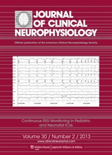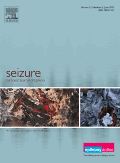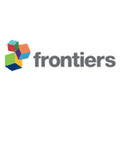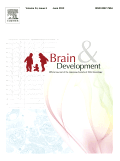
JOURNAL OF CLINICAL NEUROPHYSIOLOGY
Scope & Guideline
Bridging Theory and Practice for Better Patient Care
Introduction
Aims and Scopes
- Clinical Neurophysiology Techniques:
The journal emphasizes the development and application of various neurophysiological techniques, such as EEG, EMG, and evoked potentials, to diagnose and monitor neurological disorders. - Neurophysiological Monitoring:
A significant focus is placed on intraoperative neurophysiological monitoring to enhance surgical outcomes and minimize neurological deficits during procedures. - Research on Epilepsy:
The journal is dedicated to advancing knowledge in epilepsy through studies that explore seizure mechanisms, diagnostic methods, and innovative treatment strategies. - Neuroimaging Integration:
Integration of neuroimaging techniques with neurophysiology to enhance diagnostic accuracy and treatment planning is a core area of research. - Pediatric Neurophysiology:
There is a commitment to pediatric neurophysiology, with research focusing on the unique aspects of neurological disorders in children and the application of neurophysiological techniques in this demographic. - Emerging Technologies:
The journal explores advancements in neurotechnologies, such as transcranial magnetic stimulation and responsive neurostimulation, and their applications in clinical practice.
Trending and Emerging
- Integration of Machine Learning and AI:
There is a growing trend in utilizing machine learning algorithms to analyze neurophysiological data, which can enhance seizure detection, prognostication, and personalized treatment approaches. - Longitudinal and Home Monitoring:
Research focusing on long-term, home-based neurophysiological monitoring is emerging, driven by advancements in wearable technology and the need for continuous patient data collection outside clinical settings. - Neurophysiology in Critical Care:
An increasing number of studies are examining the role of neurophysiology in critical care settings, particularly regarding continuous EEG monitoring and its implications for patient outcomes. - Multimodal Approaches:
There is a significant rise in studies employing multimodal approaches that combine various neurophysiological techniques with neuroimaging and other diagnostic methods for comprehensive patient assessments. - Focus on Pediatric Neurophysiology:
Research specifically targeting pediatric populations is on the rise, with an emphasis on understanding the unique neurophysiological characteristics and treatment needs of children.
Declining or Waning
- Traditional Electrophysiological Techniques:
There is a noticeable decline in studies exclusively focused on traditional electrophysiological methods without integration into broader diagnostic frameworks, as newer technologies and methodologies gain prominence. - Basic Neuroscience Studies:
Research that primarily delves into basic neuroscience without direct clinical application is becoming less common, as the journal increasingly prioritizes studies with immediate relevance to clinical practice. - Neuromuscular Disorders:
Although still important, the publication of papers specifically addressing neuromuscular disorders appears to be waning, potentially due to a shift towards more integrative approaches that encompass a wider range of neurological conditions.
Similar Journals

NEUROPHYSIOLOGIE CLINIQUE-CLINICAL NEUROPHYSIOLOGY
Innovating the Future of Neurophysiological PracticesNEUROPHYSIOLOGIE CLINIQUE-CLINICAL NEUROPHYSIOLOGY is a prominent journal dedicated to advancing the field of clinical neurophysiology, published by Elsevier France - Éditions Scientifiques Médicales Elsevier. With an ISSN of 0987-7053 and an E-ISSN of 1769-7131, this journal serves as a vital platform for disseminating high-quality research and insights from 1988 through 2024. As evidenced by its excellence, the journal currently holds a Q2 ranking in the categories of Medicine (miscellaneous), Neurology, Clinical Neurology, and Medical Physiology, reflecting its impact and relevance in these critical fields. Additionally, the Scopus rankings underscore its contribution to the scientific community, particularly in clinical neurology and physiology. Researchers, professionals, and students in neurophysiology will find this journal crucial for accessing innovative studies and enhancing their understanding of clinical practices. While access to articles may vary, the journal's commitment to excellence continues to engage an international readership, fostering collaboration and knowledge advancement in the neurophysiology domain.

SEIZURE-EUROPEAN JOURNAL OF EPILEPSY
Exploring the frontiers of epilepsy management.SEIZURE - EUROPEAN JOURNAL OF EPILEPSY is a leading journal published by W B SAUNDERS CO LTD, specializing in the field of epilepsy and seizure disorders. Since its inception in 1992, this journal has committed itself to advancing research and understanding in neurology, achieving a respectable 2023 impact factor reflected by its Q2 rankings in Medicine (miscellaneous), Neurology, and Clinical Neurology categories. With an impressive Scopus ranking that places it in the top 35% of journals in Neuroscience and Neurology, SEIZURE is dedicated to promoting high-quality research and clinical studies that offer insights into epilepsy management and treatment. Although not an open-access journal, it maintains a diverse array of original articles, reviews, and case studies catering to academicians, medical professionals, and students looking to expand their knowledge on epilepsy. This journal is pivotal for those seeking to stay abreast of the latest trends, therapies, and findings in the neuroclinical landscape.

Epilepsi
Advancing epilepsy research for a brighter tomorrow.Epilepsi is an esteemed academic journal dedicated to advancing the field of epilepsy research and treatment, published by KARE PUBL. With its open access model established since 2017, the journal ensures that vital research findings are easily accessible to a global audience, thereby fostering collaboration and knowledge sharing among researchers, healthcare professionals, and students. The journal focuses on a comprehensive range of topics within neurology, including clinical studies, therapeutic advancements, and innovative approaches to epilepsy management. Located in Istanbul, Turkey, Epilepsi aims to bridge the gap between research and practice, enhancing understanding and patient care for individuals affected by epilepsy. Its commitment to high-quality, peer-reviewed content makes it a significant resource for anyone involved in epilepsy research or clinical practice.

STEREOTACTIC AND FUNCTIONAL NEUROSURGERY
Exploring New Horizons in Functional NeurologySTERREOTACTIC AND FUNCTIONAL NEUROSURGERY, published by KARGER, is a distinguished journal focusing on the evolving fields of neurosurgery and functional neurology. With its ISSN of 1011-6125 and E-ISSN of 1423-0372, this journal has been at the forefront of publishing innovative research since its inception in 1938, securing a prominent position within the scientific community through its commitment to high-quality peer-reviewed articles. As of 2023, it ranks in the Q3 quartile for Clinical Neurology and Q2 for Surgery, reflecting its impactful contributions and relevance to current medical practice. Researchers and practitioners alike will benefit from the journal’s exploration of novel techniques, therapeutic advancements, and clinical outcomes in stereotactic and functional neurosurgery, making it an invaluable resource for those aiming to stay abreast of the latest developments in this dynamic field. Although it does not currently offer open access, readers can access its content via institutional subscriptions, ensuring widespread dissemination of critical research findings aimed at improving patient care and advancing surgical methodologies.

Neurological Sciences and Neurophysiology
Elevating the discourse in neurological research.Neurological Sciences and Neurophysiology, published by Wolters Kluwer Medknow Publications, serves as a pivotal platform for dissemination and discussion of recent advancements and research in the fields of neurology and neurophysiology. Since its transition to an Open Access format in 2020, this journal aims to enhance accessibility to crucial developments in neurological sciences for researchers, professionals, and students alike. With an ISSN of 2636-865X, it seeks to bridge the gap between clinical practice and experimental science, promoting innovative approaches to neurological disorders. While currently ranked in the Q4 quartile in the Neurology category, the journal is committed to improving its standing through rigorous peer review and publication of high-quality research. The journal's scope encompasses a wide range of topics, ensuring that it appeals to a diverse audience, while its Scopus ranks indicate its emerging presence in the global scientific community. Located in Mumbai, India, the journal welcomes contributions that push the boundaries of our understanding of the nervous system, making it a vital resource for scholars in this dynamic field.

Frontiers in Human Neuroscience
Bridging Neuroscience with Behavioral InsightsFrontiers in Human Neuroscience is a premier open access journal published by FRONTIERS MEDIA SA, dedicated to advancing the understanding of the complexities of human neuroscience. With an ISSN of 1662-5161, the journal has established its prominence in various fields, achieving a Q2 ranking in categories such as Behavioral Neuroscience, Neuropsychology and Physiological Psychology, and Psychiatry and Mental Health as of 2023. Since its inception in 2008, Frontiers in Human Neuroscience has consistently contributed to the scholarly dialogue by offering a platform for innovative research that bridges the gap between neuroscience and behavioral science. The journal's rigorous peer-review process and commitment to open access ensures that findings are readily available, promoting collaboration and progress within the academic community. With an impact on neuroscience disciplines, it stands at the forefront of the field, inviting researchers, professionals, and students alike to engage with cutting-edge studies and developments. The journal's address is located in Lausanne, Switzerland, where it continues to flourish as a hub for neurobiological exploration.

Stroke Research and Treatment
Fostering collaboration to enhance stroke care worldwide.Stroke Research and Treatment is a premier Open Access journal published by HINDAWI LTD, dedicated to advancing the understanding and management of stroke and related neurological disorders. Since its inception in 2010, this journal has established itself as a valuable resource for researchers and clinicians in the field of neurology, providing a platform for high-quality, peer-reviewed articles that aim to improve patient outcomes and stimulate clinical practice innovations. With a 2023 Scopus ranking placing it in the Q3 category and a percentile ranking of 44th in clinical neurology, the journal is positioned to influence the ongoing discourse in stroke research. Stroke Research and Treatment embraces a global audience, with its editorial operations based in London, England. The journal's commitment to open access ensures that its content is freely available to all, promoting extensive dissemination and engagement in this critical field of study. Researchers, professionals, and students are encouraged to contribute their findings to this dynamic journal, fostering collaboration and knowledge sharing in the ongoing fight against stroke.

JOURNAL OF CHILD NEUROLOGY
Exploring New Horizons in Pediatric Brain HealthThe JOURNAL OF CHILD NEUROLOGY is a distinguished publication in the critical fields of neurology and pediatrics, published by SAGE PUBLICATIONS INC. With its ISSN 0883-0738 and E-ISSN 1708-8283, this journal has been a pivotal resource since its inception in 1986, serving the needs of researchers, clinicians, and students dedicated to advancing the understanding and treatment of neurological disorders in children. As evidenced by its impressive Q2 rankings in both Neurology (clinical) and Pediatrics, Perinatology, and Child Health, the journal has established a reputable position within the academic community, ranking in the 75th percentile for pediatrics and the 53rd percentile for clinical neurology. This periodical not only contributes to the body of knowledge in child neurology but also promotes interdisciplinary collaboration, engaging a global audience through innovative research articles and case studies. Although the journal is not open access, it remains committed to disseminating high-quality research aimed at improving pediatric health outcomes, making it an essential read for professionals and researchers dedicated to this crucial area of medicine.

BRAIN & DEVELOPMENT
Exploring the Intricacies of Brain DevelopmentBRAIN & DEVELOPMENT is a prestigious academic journal published by ELSEVIER, renowned for its pivotal contributions to the fields of developmental neuroscience, neurology, and pediatrics. Established in 1979, this journal has become an essential resource for researchers and clinicians alike, as it explores the complexities of brain development and associated neurological disorders in children. With an impactful focus on advancing scientific understanding, BRAIN & DEVELOPMENT is currently ranked in the Q3 quartile in Developmental Neuroscience and Clinical Neurology and Q2 in Pediatrics, reflecting its significance within the medical community. Its ISSN 0387-7604 and E-ISSN 1872-7131 underline its established presence in academic literature. While the journal does not offer open access options, it continues to be a key platform for disseminating new research findings and fostering innovation in the understanding of pediatric neurological health. The journal's commitment to quality research is further evidenced by its ongoing publication trajectory up until 2024, making it a vital source of knowledge for students, professionals, and educators in related fields.

EPILEPTIC DISORDERS
Exploring Innovations in Epileptic CareEpileptic Disorders is a leading journal dedicated to the field of epilepsy research and its clinical implications, published by Wiley. With its ISSN 1294-9361 and E-ISSN 1950-6945, the journal has established a significant presence in the medical and neurological communities, reflecting its commitment to advancing knowledge in the study of epilepsy and related disorders. Covering a broad spectrum of topics, Epileptic Disorders aims to provide a platform for researchers and clinicians to share cutting-edge research findings, clinical insights, and innovative treatments, maintaining a robust presence in Q2 quartiles across multiple categories including Medicine (miscellaneous) and Neurology. The journal, which has been in continuous publication since 1999, also ranks within the 51st and 47th percentiles in the Scopus rankings for Medicine and Neuroscience, respectively, underscoring its relevance and impact in the field. Although not an open-access publication, Epileptic Disorders remains a crucial resource for those seeking to deepen their understanding of epilepsy and improve patient care through research.